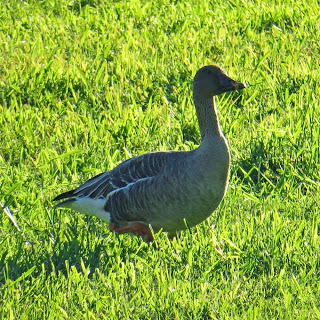 |
| Nestucca National Wildlife Refuge in Tillamock County, Oregon in the middle right of the center field is the flock that contains the rare Tundra Bean-goose |
What does the word vagrant mean to you? As with most English
words, there are several meanings that have common ground but the
synonyms that apply to birds are wanderer, drifting, maybe lost. In
biology, vagrancy applies to animals that appear well outside their
normal range.
With bird watchers, this is the holly grail. Once you have found
all the birds that live and breed in your area, getting a new bird
for the list starts to get tough. If a rare bird shows up in Oregon,
several lists can grow simultaneously. It can go on your State list,
your County list, and possibly or probably your life list if it is
from far away. It will also increase your year list. So you can see
why birders get excited by the report of a vagrant bird.
So what makes birds go off course? This is something that remains
a bit of a mystery for biologists. Some are studying the idea that
their biological makeup becomes altered and the area in their brain
that tells them which direction to go for migration is somehow
changed sending them in the wrong direction.
 |
| Tundra Bean-goose flying with Cackling Geese |
Many of the birds that are found far off course are juveniles and
are inexperienced so they just “make a wrong turn” so to speak.
They might get in with the “wrong” crowd, birds of similar
species that are headed to their own wintering ground and they just
follow them and end up vagrants. Another closely related situation
is weather. Huge storms can just blow them way off course. In fact
you will find birders becoming strangely excited when big weather
patterns are coming their way because they know that it is inevitable
that some birds that they may have never seen, could get blown in by
the storm.
This past Sunday morning, a mega rarity showed up in Oregon. A
Goose called the Tundra Bean-goose was found with a flock of Cackling
Geese at the Nestucca National Wildlife Refuge in Tillamook County,
Oregon. This is a fitting place for this bird to show up because the
refuge is set up as a wintering ground for geese, mostly the Aleutian
Cackling Goose. It is very likely that the Bean Goose got in with a flock of
Aleutian Cackling Geese and migrated down with them instead of
heading to it's normal wintering ground in Japan. It will be
interesting to see how long it stays at the refuge, presently it
seems very happy to hang out with it's cousins.
 |
| Tundra Bean-goose, November 11 2014, Nestucca NWR |
 |
| Tundra Bean-goose, November 11 2014, Nestucca NWR |
|
So you can see why I decided to head to the coast on Tuesday to
see this bird. It might be the only one I ever get a chance to see
and probably one of the most rare sightings in North America in a
while.
 |
| Tundra Bean-goose in flight |
Meanwhile, here are more birds to add to the growing list of birds
on the Amazing Bird Race.
235 American Pipit, Bear River National Wildlife Refuge, Utah
236 Carolina Wren, Chattanooga, Tennessee, (somehow I missed this
one)
237 California Quail, Bend, Oregon
238 Ferruginous Hawk, North Texas, (another one I missed)
239 Rough-Legged Hawk, North Texas, (another catchup, not sure
how these got overlooked )
240 Lesser Goldfinch, Bend, Oregon
241 Ring-necked Duck, Bear River National Wildlife Refuge, Utah
242 Tundra Bean-goose, Nestucca National Wildlife Refuge,
Tillamook County, Oregon
243 Pacific Wren, Nestucca National Wildlife Refuge, Tillamook
County, Oregon
244 Cackling Goose, Tillamook County, Oregon
245 Common Goldeneye, Tillamook County, Oregon
246 Horned Grebe, Tillamook County, Oregon
247 Brandt's Cormorant, Tillamook County, Oregon
248 Pelagic Cormorant, Tillamook County, Oregon
249 Western Gull, Pacific City, Oregon.
250 Varied Thrush, Suttle Lake, Oregon











